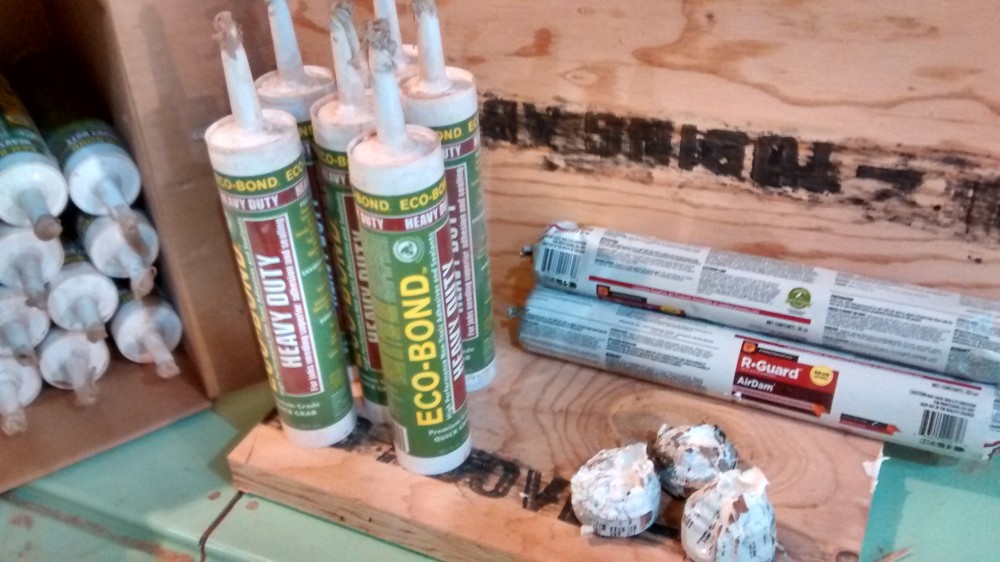Building healthy homes through non-toxic construction adhesives

Building beautiful projects that are healthy for their occupants is one of our top priorities at Greening Homes. It’s our fourth core pillar: Ensuring Healthy Indoor Air Quality. We accomplish this by setting up dust separations, protecting sensitive materials and HVAC systems from contamination during construction, running HEPA air scrubbers, and using low-emitting and non-emitting products whenever available.
Thanks to the widespread implementation of environmental building certification programs such as LEED (especially in the commercial sector) and more stringent regulations in certain jurisdictions (mainly in California), most manufacturers are now offering low-emitting products. This is amazing progress in the building industry!
Most environmental building standards, including LEED, reference the South Coast Air Quality Management District (SCAQMD) Rule 1168 to qualify whether products are low-emitting using a threshold of grams of VOCs per litre. VOCs or ‘Volatile Organic Compounds’ are the compounds that off-gas and can cause adverse human health effects and compromise air quality.
However, the SCAQMD regulations are mainly focussed on smog reduction, whereas their list of harmful VOCs and the corresponding ‘acceptable’ thresholds have been adopted as a means to ensure high indoor air quality. The problem with this is that products can meet the VOC threshold but still be harmful to human health and the planet. This is evident by browsing the adhesives and sealants at your local building store and seeing the number of products that carry both a ‘VOC compliant’ label and a skull-and-cross-bones warning.
At Greening Homes, we strive to do the best we can for the health of the home owners we work for and the planet. Rather than settle for less-harmful or barely-compliant products, we want to use the safest and healthiest options available. In the case of adhesives, we want to let you know about two exciting developments:
Eco-Bond HD in Sausage Packaging
This is a popular adhesive amongst green builders because it is non-toxic and has no emissions, but I was disillusioned by the amount of packaging waste. The product was only available in small caulking tubes made of a very robust plastic. Surely we could have a non-toxic adhesive AND minimal packaging waste?
I contacted the manufacturer and supplier to source the product in sausages, a packaging format popular in commercial construction that uses a thin casing rather than a rigid tube, resulting in a 95 percent reduction in packaging waste! Now we can use an excellent non-toxic adhesive without filling up our landfills or taxing the recycling system. Another advantage of the sausages is that they carry more material (meaning less reloading) and use a superior gun (less wrist fatigue, easier application, better dispensing control, etc.).
Prosoco R-Guard AirDam
Thanks to Brandon Weiss of Evolutionary Home Builders for sharing this tip during a tour of one of his projects in the recent North American Passive House Conference in Chicago. The most exciting thing about this product for us is that it is Living Building Challenge Red List Free. What does that mean? The Living Building Challenge is widely regarded as the ultimate green building rating system, certifying projects that have a net-positive, regenerative impact on the planet and society.
One of their initiatives is the Declare product labeling system. Similar to the ingredient labels we see on food, it aims to get manufacturers to declare all the ingredients found in their products so that people know exactly what they are buying. The Declare initiative includes a Red List, which is a list of “materials, chemicals, and elements known to pose serious risk to human health and the greater ecosystem.”
We are very excited to report that AirDam (and a number of other Prosoco R-Guard products we will be using) are Certified Red List Free. While AirDam is a sealant used at the perimeters of windows and doors to air seal the frame to the air barrier, Brandon has also been using it as a subfloor adhesive on his projects. As a sealant that passes Category 5 hurricane testing, AirDam has excellent adhesive properties.
I discussed this use with the manufacturer, and while it is not the product’s intended use, he did reference the adhesive strength in their ASTM testing and that the chemical formulation on which the product is based was first developed as an adhesive. Sourcing the product in Toronto was difficult; however, Greening Homes is now a distributor to be able to import it directly from the U.S.
We are now using Eco-Bond HD as our standard general-purpose construction adhesive and AirDam as our subfloor adhesive on all our sites.
By Steven Gray, Construction Manager, Greening Homes